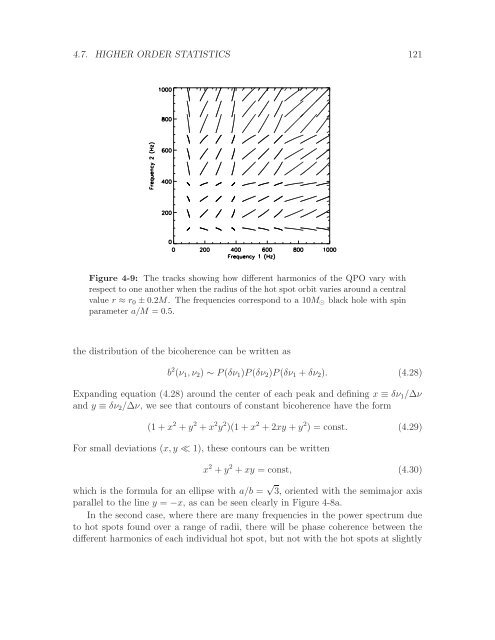Radiation Transport Around Kerr Black Holes Jeremy David ...
Radiation Transport Around Kerr Black Holes Jeremy David ...
Radiation Transport Around Kerr Black Holes Jeremy David ...
Create successful ePaper yourself
Turn your PDF publications into a flip-book with our unique Google optimized e-Paper software.
4.7. HIGHER ORDER STATISTICS 121<br />
Figure 4-9: The tracks showing how different harmonics of the QPO vary with<br />
respect to one another when the radius of the hot spot orbit varies around a central<br />
value r ≈ r 0 ± 0.2M. The frequencies correspond to a 10M ⊙ black hole with spin<br />
parameter a/M = 0.5.<br />
the distribution of the bicoherence can be written as<br />
b 2 (ν 1 , ν 2 ) ∼ P(δν 1 )P(δν 2 )P(δν 1 + δν 2 ). (4.28)<br />
Expanding equation (4.28) around the center of each peak and defining x ≡ δν 1 /∆ν<br />
and y ≡ δν 2 /∆ν, we see that contours of constant bicoherence have the form<br />
(1 + x 2 + y 2 + x 2 y 2 )(1 + x 2 + 2xy + y 2 ) = const. (4.29)<br />
For small deviations (x, y ≪ 1), these contours can be written<br />
x 2 + y 2 + xy = const, (4.30)<br />
which is the formula for an ellipse with a/b = √ 3, oriented with the semimajor axis<br />
parallel to the line y = −x, as can be seen clearly in Figure 4-8a.<br />
In the second case, where there are many frequencies in the power spectrum due<br />
to hot spots found over a range of radii, there will be phase coherence between the<br />
different harmonics of each individual hot spot, but not with the hot spots at slightly
















